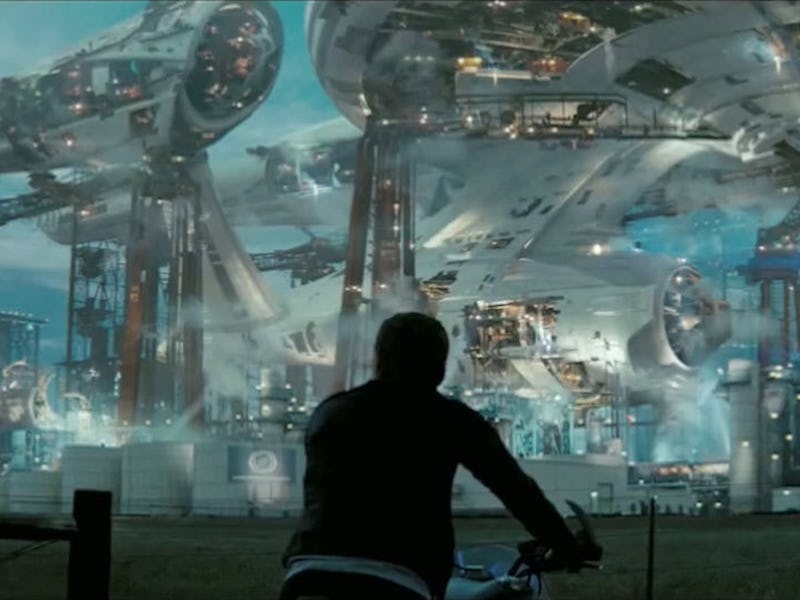13 years ago, J.J. Abrams unveiled his greatest sci-fi achievement ever
Shaking off the franchise’s reputation as a cult object, the teaser for J.J. Abrams’ Star Trek was a crowdpleasing triumph.

Long before Hollywood’s current era of IP strip-mining and geek supremacy, Paramount made a surprising decision with its 2009 Super Bowl spot for J.J. Abrams’ anticipated Star Trek reboot.
Rather than lean heavily into the decades of mythos that had made the franchise something of a cult oddity, what the 30-second teaser for Star Trek, debuted in the middle of the game, did so smartly was tell a story about underdogs — with broad appeal.
“You’ve always had a hard time finding your place in this world,” assesses Bruce Greenwood’s Starfleet captain, speaking to a young Chris Pine who’s just been beaten up inside what looks like a futuristic casino.
Opening on an unidentified character staggering through a snowy wilderness, the teaser’s first shot suggests this guy will be our protagonist. But it isn’t until he rides up on his motorcycle to gaze up at a glowing spacecraft launch site — “I dare you to do better,” Greenwood adds — and shares a flask with Karl Urban’s character mid-takeoff that we get confirmation. After Urban’s Leonard McCoy introduces himself, Pine reveals his name: “Jim Kirk.”
That’s a big reveal, and the teaser treats it as such, a fast-tempo score starting up as we get flashes of roaring alien species, the tattooed Romulan villain (Eric Bana), Hikaru Sulu (John Cho) mid-combat, and the thrilling sight of U.S.S. Enterprise charging into battle.
Zachary Quinto’s Spock and Chris Pine’s Kirk.
Perhaps informed by the more mechanically driven, gasoline-and-glory spectacle of Paramount’s then-massive Transformers franchise — and certainly by the aura of mystery then commanded by Abrams, the creator of ABC’s Lost — the Star Trek teaser features plenty of aircraft carriers and violent explosions. But for all its suggestion of advanced weaponry and intergalactic conflict, this Star Trek teaser confirmed how Abrams’ remake would make central characters like Kirk and Spock emotional and relatable again.
The tagline, “This Summer, The Future Begins,” hints at the film’s science-fiction bona fides without committing to anything so niche as a callback to ”the final frontier.” Zachary Quinto’s Spock beams down in the midst of a battle, Starfleet cadets rushing outside to witness a laser-beam in the distance, and — most telling of all — Zoe Saldana’s Nyota Uhura smiles at Kirk before he’s glimpsed in the throes of passion with another beautiful woman. In mere seconds, Star Trek established that this younger Kirk is still a ladies’ man and a rapscallion, a fresh-faced shoot-from-the-hip-style upstart who still has a long way to go before becoming the Captain Kirk associated with William Shatner.
Finally, to send the trailer home, Star Trek deploys a more human-scaled action sequence to offset all its shots of planetary destruction and spaceship-inflicted carnage. Kirk and his fellow recruits attempt a dangerous space-jump as he gleefully hoots and hollers.
Chris Pine’s Kirk scales an icy ravine.
As a course correction for a franchise that had hit its box office in 1986, Abrams’ Star Trek succeeded with flying colors. A box-office success, it made over $385 million worldwide. Critics were even more enthusiastic about its blend of character development and sleekly designed, breathlessly staged action. It even became the first Star Trek movie to win an Oscar (for Best Makeup), landing four overall nominations.
Paramount set the film on the right course with this Super Bowl ad, communicating the sense of buoyancy and visceral action that would transform Star Trek from a cult classic into a newly relevant crowd-pleaser. Abrams’ film was made to satisfy fans of big-budget popcorn cinema as much as fans of the pre-existing franchise mythology.
Marvel could stand to take some notes.
For more like this:
Correction: An earlier version of this article attributed the role of Bruce Greenwood’s Starfleet captain to a different Bruce. We regret the error.
This article was originally published on